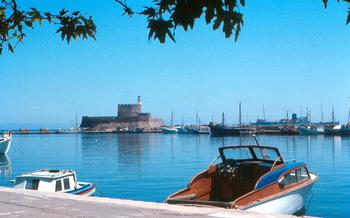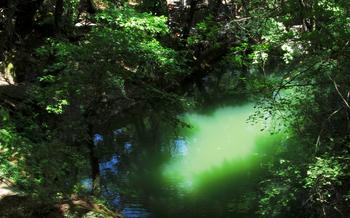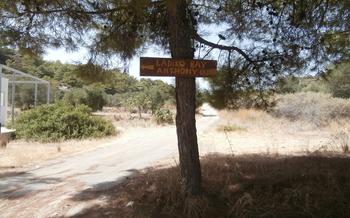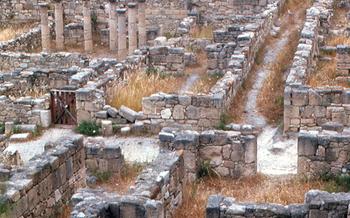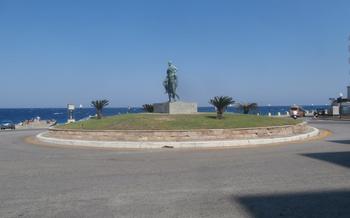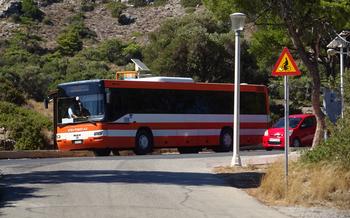
Kamiros Ancient City
- Location and Accessibility
- Exploring the City Ruins
- The Acropolis of Kamiros
- The Residential Quarters
- The Agora (Marketplace)
- The Fortifications
- The Necropolis: A Journey into Ancient Beliefs
- The Museum of Kamiros: A Window into the Past
- Guided Tours and Audio Guides
- Best Time to Visit
- Entrance Fees and Opening Hours
- Facilities and Amenities
- Nearby Attractions
- Insider Tip: Hidden Gems
Location and Accessibility
Finding Kamiros: Embark on a journey to the captivating south-western corner of Rhodes, where the remnants of ancient Kamiros lie nestled between the azure waters of the Mediterranean Sea and the rugged slopes of Mount Profitis Ilias. This archaeological treasure is a mere 35 kilometers from the vibrant capital, Rhodes Town, making it an ideal day trip destination for history buffs and curious travelers alike.
Transportation: Reach Kamiros with ease, as local buses depart frequently from Rhodes Town and offer a scenic ride along the picturesque coastal road. For those seeking a more flexible and immersive experience, car rentals are readily available, allowing you to set your own pace and explore the surrounding area at your leisure.
Parking: As you approach Kamiros, you'll be greeted by a convenient parking area situated a short walk from the ancient city's entrance. Leave your vehicle behind and prepare to step back in time as you embark on a journey through the captivating ruins of this once-thriving metropolis.
Exploring the City Ruins
Walking trails and paths: Your exploration of Kamiros begins along well-marked trails that wind through the ancient ruins. These paths take you on a journey through time, allowing you to step into the footsteps of the city's former inhabitants. As you wander along these paths, imagine the bustling streets, the lively marketplace, and the conversations that once echoed through these spaces.
Must-see landmarks and structures: Among the must-see landmarks in Kamiros are the impressive city walls, which once protected the city from invaders. The remains of the acropolis, perched on a hilltop, offer breathtaking views of the surrounding landscape. Don't miss the temple of Athena, the patron goddess of the city, which stands as a testament to the religious beliefs of the ancient Kamirians.
Signs and information boards: Throughout the site, you'll find informative signs and information boards that provide insights into the history, culture, and architecture of Kamiros. These signs help you understand the significance of the ruins and bring the ancient city to life.
The Acropolis of Kamiros
The acropolis of Kamiros is undeniably the most captivating part of the city's ruins. Perched atop a hill, it offers breathtaking views of the sparkling Aegean Sea and the verdant valley below, making it an ideal spot to capture panoramic photographs.
As you ascend the winding path to the acropolis, you'll be greeted by the ruins of various structures, including a temple dedicated to Apollo, the patron god of the city. While the temple is now reduced to rubble, its majestic columns and intricate carvings hint at its former grandeur.
The acropolis also boasts the well-preserved remains of other significant buildings, including storehouses, workshops, and public buildings. These structures provide valuable insights into the daily life and economy of ancient Kamiros, showcasing the city's prowess in trade and craftsmanship.
The strategic location of the acropolis is another testament to the city's strategic importance. Perched high on a hill, it served as a watchtower, allowing the inhabitants to keep a vigilant eye on their surroundings and potential threats.
Overall, the acropolis of Kamiros is a must-visit for anyone interested in the history and culture of this ancient city. Its stunning views, evocative ruins, and strategic significance make it an unforgettable highlight of any visit to Rhodes.
The Residential Quarters
The residential quarters of Kamiros are a fascinating glimpse into the everyday life of the ancient city's inhabitants. As you explore the ruins, you'll encounter the remains of houses, streets, and even public buildings that once served the community.
Houses and Streets: The houses in Kamiros were typically small and made of stone, with a central courtyard and a few rooms arranged around it. The streets were narrow and winding, often with steps leading up to the houses.
Everyday Life: Imagine walking through these streets and seeing the ancient Kamirians going about their daily lives. They would have been busy with various tasks, such as cooking, cleaning, weaving, and tending to their gardens. The city was also home to artisans, who crafted pottery, jewelry, and other goods.
Mosaics and Wall Paintings: Some of the houses in Kamiros have preserved beautiful mosaics and wall paintings. These intricate artworks depict scenes from mythology, nature, and everyday life. They offer a glimpse into the artistic traditions and beliefs of the ancient inhabitants.
The Agora (Marketplace)
At the heart of Kamiros, the agora played a pivotal role as the center of economic and social activities. Excavations have revealed an extensive network of shops, warehouses, and public spaces that once bustled with trade and commerce. The agora served as a gathering place for locals to buy and sell goods, exchange news and ideas, and conduct business. Its strategic location near the harbor facilitated the import and export of goods, contributing to Kamiros' flourishing economy.
Key Features:
-
Shops and Warehouses: The agora was lined with numerous shops and warehouses where merchants displayed their wares and stored their goods. These structures varied in size and design, reflecting the diverse range of products traded in the marketplace.
-
Public Spaces: Open plazas and courtyards within the agora provided spaces for public gatherings, meetings, and celebrations. These areas were often adorned with statues, fountains, and other decorative elements, creating a vibrant and bustling atmosphere.
-
Administrative Buildings: The agora also housed administrative buildings where officials conducted business and managed the affairs of the city. These buildings often included offices, record-keeping facilities, and meeting rooms.
Significance:
The agora played a crucial role in the daily life of Kamiros' inhabitants. It was not merely a center of commerce but also a social and political hub. The exchange of goods and ideas that took place in the agora contributed to the city's cultural and economic prosperity.
The Fortifications
Kamiros' strategic position demanded strong defenses to protect its inhabitants and wealth. The city's fortifications were a testament to its military prowess and engineering skills. Massive walls, reaching a height of 7 meters, encircled the city, punctuated by sturdy towers that provided a vantage point for the guards. The walls were constructed using large blocks of limestone and featured intricate gateways, some of which are still visible today.
The placement of the towers allowed for effective surveillance and crossfire, making it difficult for attackers to breach the defenses. The city's strategic location on a hilltop further enhanced its defensive capabilities, providing a natural vantage point and making it difficult for enemies to approach undetected.
The effectiveness of the fortifications is evident in the city's ability to withstand numerous sieges and attacks throughout its history. While the city eventually fell to invading forces, the resilience of its fortifications speaks to the ingenuity and determination of its ancient builders. Today, visitors can explore the remains of the fortifications, marveling at the engineering prowess of the Kamirians and gaining a glimpse into the city's turbulent past.
The Necropolis: A Journey into Ancient Beliefs
Beyond the city walls lies the necropolis of Kamiros, an ancient cemetery that offers a glimpse into the beliefs and customs of its inhabitants. Elaborate tombs, some carved into the rock, stand as testaments to the importance placed on the afterlife. These tombs vary in size and decoration, reflecting the social status of the deceased.
Within the necropolis, you can observe different burial practices. Some tombs contain multiple burials, suggesting family plots or communal traditions. Others feature intricate carvings and inscriptions, providing insights into the lives and achievements of the individuals laid to rest.
The necropolis also reveals the influence of various cultures on ancient Kamiros. You can find tombs that incorporate elements of Greek, Egyptian, and Phoenician funerary customs, highlighting the cosmopolitan nature of the city.
Exploring the necropolis is a poignant experience that allows you to connect with the past and gain a deeper understanding of the ancient Kamirians' beliefs about death and the afterlife.
The Museum of Kamiros: A Window into the Past
Enrich your understanding of ancient Kamiros with a visit to the on-site museum, a treasure trove of artifacts that bring the city's history to life. Step inside to discover a fascinating array of pottery, jewelry, tools, and other relics excavated from the site. These precious objects offer a glimpse into the daily lives, customs, and artistry of the Kamirians.
The museum's collection is meticulously curated and displayed, providing valuable insights into the city's rich cultural heritage. Admire the intricate designs of ceramic vessels, each telling a story of craftsmanship and everyday use. Marvel at the delicate jewelry pieces, adorned with precious stones and symbols of ancient beliefs. Examine the tools that shaped the city, from agricultural implements to architectural elements.
Don't miss the museum's collection of inscriptions, which shed light on the political, social, and economic aspects of Kamiros. These ancient texts, etched in stone, provide glimpses into the laws, religious practices, and trade relations of the city.
The Museum of Kamiros is an essential stop for anyone seeking a deeper understanding of this ancient metropolis. Through its carefully preserved artifacts, the museum offers a tangible connection to the past, allowing visitors to experience the vibrant history and culture of Kamiros firsthand.
Guided Tours and Audio Guides
Explore with Experts or at Your Own Pace
Kamiros offers a range of guided tour options for those seeking a deeper understanding of its history and significance. Knowledgeable guides bring the ancient city to life, narrating tales of its past and pointing out hidden details that might otherwise go unnoticed. Guided tours typically cover all the major landmarks, including the acropolis, agora, residential quarters, and fortifications.
For those who prefer to explore at their own pace, audio guides are available for rent. These guides provide a self-guided tour of the city, allowing visitors to learn about its history and various points of interest as they wander through the ruins. The audio guides are available in multiple languages, ensuring that visitors from all over the world can enjoy a comprehensive and informative experience.
Whether you opt for a guided tour or an audio guide, both options offer a unique and enriching way to explore the ancient city of Kamiros. Choose the option that best suits your preferences and delve into the fascinating world of this once-thriving city.
Best Time to Visit
When to Explore Kamiros for an Optimal Experience
To fully appreciate the wonders of Kamiros Ancient City, timing is crucial. The ideal period to visit is during the shoulder seasons, spring (April-May) and autumn (September-October). During these months, the weather is pleasant and warm, with average temperatures ranging from 18°C to 25°C. The crowds are smaller, allowing for a more intimate and immersive experience.
Summer (June-August), while offering longer daylight hours, can be overwhelmingly hot and crowded, with temperatures often exceeding 30°C. Winter (November-March), on the other hand, brings chilly temperatures and occasional rainfall, making exploration less enjoyable.
To avoid the midday sun, plan your visit for early morning or late afternoon, when the lighting is also ideal for photography. Check the weather forecast before your visit to ensure you're prepared for any weather conditions.
Entrance Fees and Opening Hours
Visiting the Kamiros Ancient City comes with an admission fee that grants access to the site's ruins, museum, and all available facilities. The current ticket price is set at a reasonable amount, making it accessible to travelers of all budgets.
The site's operating hours vary depending on the season. During the summer months, typically from April to October, Kamiros is open to the public from morning until late afternoon, allowing ample time to explore the ruins and enjoy the museum's exhibits. During the winter months, from November to March, the site's hours may be reduced due to shorter daylight hours, so it's advisable to check the official website or local tourism offices for the most up-to-date information.
Discounts and concessions are available for certain groups, including students, seniors, and families. It's always a good idea to inquire about these discounts when purchasing tickets to take advantage of any savings.
Facilities and Amenities
Kamiros Ancient City is equipped with essential facilities to enhance the comfort and convenience of visitors.
-
Restrooms and Drinking Water: Well-maintained restrooms are available within the archaeological site, ensuring visitors' convenience. Drinking water fountains are also strategically placed to quench your thirst during your exploration.
-
Gift Shop and Souvenirs: A gift shop located near the entrance offers a variety of souvenirs, including replicas of ancient artifacts, postcards, and traditional Greek handicrafts. These souvenirs serve as cherished mementos of your visit to Kamiros.
-
Accessibility for Visitors with Disabilities: Kamiros Ancient City is committed to ensuring accessibility for all visitors. Wheelchair-accessible paths and ramps allow individuals with mobility challenges to navigate the site with ease. Designated parking spaces for disabled visitors are also available.
Nearby Attractions
Beyond the ancient city of Kamiros, the island of Rhodes offers a wealth of other attractions to explore. Just a short drive away, you can visit the picturesque village of Embonas, renowned for its wine production and traditional Greek tavernas. For beach lovers, the crystal-clear waters and golden sands of Tsambika Beach and Agathi Beach are must-visits.
If you're interested in more historical sites, the ancient acropolis of Lindos and the medieval village of Monolithos are both within easy reach. Nature enthusiasts can explore the scenic trails of the Seven Springs Valley or take a boat trip to the nearby island of Chalki.
To make the most of your time on Rhodes, consider planning an itinerary that combines visits to Kamiros with other nearby attractions. For example, you could spend the morning exploring the ancient city, then relax on the beach in the afternoon. Alternatively, you could combine a visit to Kamiros with a wine tasting tour in Embonas or a boat trip to Chalki.
With so much to see and do in the vicinity of Kamiros, you'll be spoilt for choice. Be sure to allow enough time to explore all that this beautiful island has to offer.
Insider Tip: Hidden Gems
Beyond the main attractions of Kamiros, there are several hidden gems waiting to be discovered by curious explorers. In the residential quarters, keep an eye out for a well-preserved mosaic depicting a charming scene of everyday life in ancient Greece. As you wander through the agora, look for a small, unassuming stone that bears an ancient inscription, offering a glimpse into the commercial transactions of the past.
In the museum, take some time to admire the intricate gold jewelry on display, showcasing the artistry and craftsmanship of Kamiros's ancient goldsmiths. And if you're lucky, you might catch a glimpse of the resident archaeologist working on the latest discoveries, providing a firsthand account of the ongoing research and excavations at this remarkable site.

